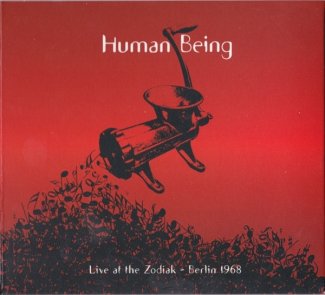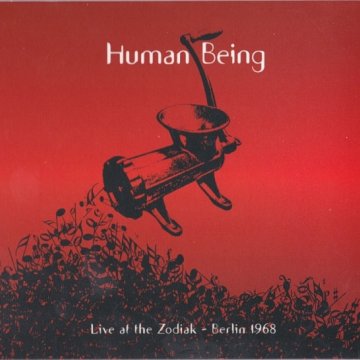
Live At The Zodiak - Berlin 1968
One of the very earliest 'Krautrock' artefacts. Released a few months before the Can and Tangerine Dream debuts. A 56-minute abstract soundscape taped from a live gig at the Zodiak Free Arts Lab , West Berlin's late 1960s underground music club.
Where do we start? Let’s take summer 1968 at the Zodiak underground music club beneath 32 Hallesches Ufer in West Berlin’s Kreuzberg Quarter. It was here that Human Being’s uncompromisingly loud debut rattled the foundations of the Wirtschaftswunder, West Germany’s post-war economic miracle, as if willing it to collapse.
The tools of the 1960s American and British rock trade – guitar, organ, drums – were present and correct. But this wasn’t the sound of The Doors or Rolling Stones. The instruments were scraped and beaten, fed through early reverb, delay and echo units, the output sounding like industrial machines gone berserk. Tune into Live at the Zodiak 1968, with the volume up to the max, and you’ll know why people came away stunned by the alien weirdness of it all.
Human Being was a collective of non-musicians with anti-hippie black t-shirts and pre-punk defiance; the nucleus included Norbert Eisbrenner, Elke Lixfeld, Broderick Price, Beatrix Rief, Hans-Joachim Roedelius, Boris Schaak, Verena Schirz and Christoph Sievernich. Even to the seriously hip Zodiak crowd with a cocked ear for Hendrix and Zappa imports, the Human Being experience was unlike any before it. Yet repeat listens to Live at the Zodiak 1968 tells us their 400-volt noise was charged with a human impulse. “If you organise this noise,” the Zodiak’s founder Conrad Schnitzler told Roedelius, “it’s not just pure chaos, it can grow into music.” And out of the chaos, a sense of redemption – for a post-Nazi nation sick of the past and confused about the future.
Astonishingly, for nearly 40 years there were no known recordings from the Zodiak. Then an unnamed fan, who had documented one Human Being gig on his portable Uher reel-to-reel machine, contacted Roedelius out of the blue with 64 minutes of quarter-inch stereo tape. And finally, four decades later one of Krautrock's earliest milestones - taped several months before the first Tangerine Dream album is finally available.
At the start of Live at the Zodiak 1968, there’s none of the props or comfort zones that even free jazz relied on – opening themes or reassuring 4/4 bars for providing a launch pad into the unknown. It opens to an ill-defined murk of low sounds punctuated by Schaak’s slow marching beat which reverberates like an oil drum. As metallic echoes glance off uncertain acoustic spaces, we’re led into a twilight zone filled with Price’s sustained guitar drones and Eisbrenner’s solemn one note saxophone bleats.
Over the first ten minutes, there’s almost no development. Yet an exquisite tension arises between the crude mechanical means of generating sound and their flowing Japanese watercolour-like immediacy. A swelling electronic current of heavily processed cello tones, a distant electronic blipping, ecstatic waves of Syd Barrett-like slide guitar produced by running a cigarette lighter over the strings. The soft percussive clatter of found objects, ghostly wordless chants. While the instrumental technique is defiantly basic it yields the sonic equivalent of the Merzbau of Kurt Schwitters – the 1930s Dadaist who alchemised beauty out of litter and debris. Gradually it picks up urgency, becomes louder and more insistent.
As electronic drones rise and fall like hills, a tangible sense of landscape emerges. But it’s not picture music: (“You can’t paint a German landscape once a tank has driven through it,” declared the new wave artist Anselm Kiefer). If we can’t see the landscape we can hear the sounds as we journey through it; sometimes sad, confused or harsh, sometimes reflective, tender or optimistic. So this is a psychic soundscape, then – utterly synthetic yet burdened with human knowledge.
Over the 64-minute distance there’s an inner logic of tension, release, sustain and interval. For listeners with staying power it eventually rewards patience by climbing to an angry, almost symphonic peak of white noise. As it falls away to the final silence, you’re left with an intoxicating shock of discovery that even the most virtuosic of late 1960s free jazz and psychedelic rock often struggled to achieve.
Source: Stephen Iliffe
